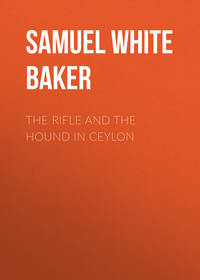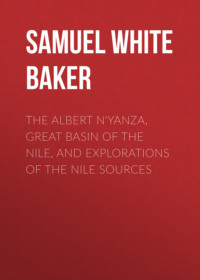 полная версия
полная версияWild Beasts and Their Ways, Reminiscences of Europe, Asia, Africa and America. Volume 1
It is well known that the entire males of many domestic animals are naturally savage. The horse, bull, boar, and the park-fed stag are all uncertain in their tempers and may be pronounced unsafe; but the male elephant, although dangerous to a stranger and treacherous to his attendants, combines an extraordinary degree of cowardice with his natural ferocity. A few months ago I witnessed a curious example of this combination in the elephant's character. A magnificent specimen had been lent to me by the Commissariat Department at Jubbulpur; this was a high caste bull elephant named Bisgaum that was well known as bad-tempered, but was supposed to be courageous. He had somewhat tarnished his reputation during the last season by turning tail upon a tiger that rushed out of dense bush and killed a coolie within a few yards of his trunk; but this momentary panic was excused, and the blame was thrown upon the mahout. The man was dismissed, and a first-rate Punjaubi driver was appointed in his stead. This man assured me that the elephant was dependable; I accordingly accepted him, and he was ordered to carry the howdah throughout the expedition.
In a very short experience we discovered the necessity of giving Bisgaum a wide berth, as he would fling out his trunk with extreme quickness to strike a person within his reach, and he would kick out sharply with his hind leg whenever a native ventured to approach his rear. He took a fancy to me, as I fed him daily with sugar-canes, jaggery, and native chupatties (cakes), which quickly established an understanding between us; but I always took the precaution of standing by his side instead of in his front, and of resting my left hand upon his tusk while I fed him with the right. Every morning at daylight he was brought to the tent with Demoiselle (the female elephant), and they both received from my own hands the choice bits which gained their confidence.
My suspicions were first aroused by his peculiar behaviour upon an occasion when we had killed two tigers; these were young animals, and although large, there was no difficulty in arranging them upon the pad, upon which they were secured by ropes, when the elephant kneeling down was carefully loaded. Hardly had Bisgaum risen to his feet, when, conscious of the character of the animals upon his back, and, I suppose, not quite certain that life was actually extinct, he trumpeted a shrill scream, and shook his immense carcase like a wet dog that has just landed from the water. This effect was so violent that one tiger was thrown some yards to the right, while the other fell to the ground on the left, and without a moment's warning, the elephant charged the lifeless body, sent it flying by a kick with his fore foot, and immediately proceeded to dance a war-dance, kicking with his hind legs to so great a height that he could have reached a tall man's hat. A vigorous application of the driving-hook by the mahout, who was a powerful man, at length changed the scene, and the elephant at once desisted from his attack upon the dead tiger, and rushed madly upon one side, where he stood nervously looking at the enemy as though he expected it would show signs of life.
This did not look promising for an encounter with a live tiger, as it would have been absolutely impossible to shoot from that elephant's back.
A short time after this occurrence, when upon my usual reconnaissance through the jungles in the neighbourhood of the camp, I came upon the fresh tracks of a large tiger close to the banks of the Bearmi river, and I gave the necessary instructions that a buffalo should be tied up as a bait that same evening.
Early on the following morning the news was brought by the shikaris that the buffalo had been killed, and dragged into a neighbouring ravine. As the river was close by, there could be no doubt that the tiger would have drunk water after feasting on the carcase, and would be lying asleep somewhere in the immediate neighbourhood.
The mucharns (platforms in trees) had already been prepared in positions where the tiger was expected to pass when driven, as he would make for the forest-covered hills which rose within half a mile of the river.
The spot was within twenty minutes of the camp; the elephants were both ready, with simple pads, as the howdah was ill-adapted for a forest; and we quickly started.
Three mucharns had been prepared; these were about 100 yards apart in a direct line which guarded a narrow glade between the jungle upon the river's bank and the main body of the forest at the foot of a range of red-sandstone hills; these were covered to the summit with trees already leafless from the drought.
The mucharn which fell to my share was that upon the right flank when facing the beat; this was in the open glade opposite a projecting corner of the jungle. On the left, about 70 yards distant, was a narrow strip of bush connected with the jungle, about 4 yards wide, which terminated in a copse about 30 yards in diameter; beyond this was open glade for about 40 yards width until it bounded the main forest at the foot of the hill-range.
We took our places, and I was assured by the shikaris that the tiger would probably break covert exactly in my front.
It is most uncomfortable for a European to remain squatted in a mucharn for any length of time; the limbs become stiffened, and the cramped position renders good shooting anything but certain. I have a simple wooden turnstool, which enables me to shoot in any required direction; this is most comfortable.
I had adjusted my stool upon a thick mat to prevent it from slipping, and having settled myself firmly, I began to examine the position to form an opinion concerning the most likely spot for the tiger to emerge from the jungle.
The beat had commenced, and the shouts and yells, of a long line of 150 men were gradually becoming more distinct. Several peacocks ran across the open glade: these birds are always the forerunners of other animals, as they are the first to retreat.
Presently I heard a rustle in the jungle, and I observed the legs of a sambur deer, which, having neared the edge, now halted to listen to the beaters before venturing to break from the dense covert. The beaters drew nearer, and a large doe sambur, instead of rushing quickly forward, walked slowly into the open, and stood within 10 yards of me upon the glade. She waited there for several minutes, and then, as if some suspicion had suddenly crossed her mind, gave two or three convulsive bounds and dashed back to the same covert from which she had approached.
It struck me that the sambur had got the wind of an enemy, otherwise she would not have rushed back in such sudden haste; she could not have scented me, as I was 10 or 12 feet above the ground, and the breeze was aslant . . . . Then, if a tiger were in the jungle, why should she dash back into the same covert ?
I was reflecting upon these subjects, and looking out sharp towards my left and front, when I gently turned upon my stool to the right; there was the tiger himself! who had already broken from the jungle about 75 yards from my position. He was slowly jogging along as though just disturbed (possibly by the sambur), keeping close to the narrow belt of bushes already described. There was a foot-path from the open glade which pierced the belt; I therefore waited until he should cross this favourable spot. I fired with the '577 rifle just as he was passing across the dusty track. I saw the dust fly from the ground upon the other side as the hardened bullet passed like lightning through his flank, but I felt that I was a little too far behind his shoulder, as his response to the shot was a bound at full gallop forwards into the small clump of jungle that projected into the grassy open. My turnstool was handy, and I quickly turned to the right, waiting with the left-hand barrel ready for his reappearance upon the grass-land in the interval between the main jungle and the narrow patch. There was no time to lose, for the tiger appeared in a few seconds, dashing out of the jungle, and flying over the open at tremendous speed. This was about 110 yards distant; aiming about 18 inches in his front, I fired. A short but spasmodic roar and a sudden convulsive twist of his body showed plainly that he was well hit, but with unabated speed he gained the main forest which was not more than 40 yards distant. If that had been a soft leaden bullet he would have rolled over to the shot, but I had seen the dust start from the ground when I fired, and I knew that the hard bullet had passed through without delivering the shock required.
The beaters and shikaris now arrived, and having explained the incident, we examined the ground for tracks, and quickly found the claw-marks which were deeply indented in the parched surface of fine sward. We followed these tracks cautiously into the jungle. Our party consisted of Colonel Lugard, the Hon. D. Leigh, myself, and two experienced shikaris. Tiger-shooting is always an engrossing sport, but the lively excitement is increased when you follow a wounded tiger upon foot. We now slowly advanced upon the track, which faintly showed the sharp claws where the tiger had alighted in every bound. The jungle was fairly open, as the surface was stony, and the trees for want of moisture in a rocky soil had lost their leaves; we could thus see a considerable distance upon all sides. In this manner we advanced about 100 yards without finding a trace of blood, and I could see that some of my people doubted the fact of the tiger being wounded. I felt certain that he was mortally hit, and I explained to my men that the hard bullet would make so clean a hole through his body that he would not bleed externally until his inside should be nearly full of blood. Suddenly a man cried "koon" (blood), and he held up a large dried leaf of the teak-tree upon which was a considerable red splash: almost immediately after this we not only came upon a continuous line of blood, but we halted at a place where the animal had lain down; this was a pool of blood, proving that the tiger would not be far distant.
I now sent for the elephants, as I would not permit the shikaris to advance farther upon foot. The big tusker Bisgaum arrived, and giving my Paradox gun to my trustworthy shikari Kerim Bux, he mounted the pad of that excitable beast to carry out my orders, "to follow the blood until he should find the tiger, after which he was to return to us." We were now on the top of a small hill within an extensive forest range, and directly in front the ground suddenly dipped, forming a V-shaped dell, which in the wet season was the bed of a considerable torrent. It struck me that if the tiger were still alive he would steal away along the bottom of the rocky watercourse; therefore, before the elephant should advance, and perhaps disturb him, we should take up a position on the right to protect the nullah or torrent-bed; this plan was accordingly carried out.
We had not been long in our respective positions when a shot from the direction taken by the elephant, followed instantly by a short roar, proved that the tiger had been discovered, and that he was still alive. My female elephant Demoiselle, upon hearing the sound, trembled beneath me with intense excitement, while the other female would have bolted had she not been sharply reminded by the heavy driving-hook. Several shots were now fired in succession, and after vainly endeavouring to discover the whereabouts of the tiger, I sent Demoiselle to obtain the news while we kept guard over the ravine. No tiger having appeared, I stationed natives in trees to watch the nullah while we ascended the hill on foot, directing our course through the forest to the place from whence the shots had been fired. We had hardly advanced 80 yards before we found both the elephants on the top of the steep shoulder of the hill, where several of our men were upon the boughs of surrounding trees. Bisgaum was in a state of wild excitement, and Kerim Bux explained that it was impossible to shoot from his back, as he could not be kept quiet. Where was the tiger? That was the question. "Close to us, Sahib!" was the reply; but on foot we could see nothing, owing to high withered grass and bush. I clambered upon the back of the refractory Bisgaum, momentarily expecting him to bolt away like a locomotive engine, and from that elevated position I was supposed to see the tiger, which was lying in the bottom of the ravine about 100 yards distant. There were so many small bushes and tufts of yellow grass that I could not distinguish the form for some minutes; at length my eyes caught the object. I had been looking for orange and black stripes, therefore I had not noticed black and white, the belly being uppermost, as the animal was lying upon its back, evidently dying.
The side of the rocky hill was so steep and slippery that the elephants could not descend; I therefore changed my steed and mounted Demoiselle, from the back of which I fired several shots at the tiger until life appeared to be extinct. The ground was so unfavourable that I would not permit any native to approach near enough to prove that the animal was quite dead. I therefore instructed Bisgaum's mahout to make a detour to the right until he could descend with his elephant into the flat bottom of the watercourse, he was then to advance cautiously until near enough to see whether the tiger breathed. At the same time I rode Demoiselle carefully as near as we could safely descend among the rocks to a distance of about 40 yards; it was so steep that the elephant was impossible to turn. From this point of vantage I soon perceived Bisgaum's bulky form advancing up the dry torrent-bed. The rocks were a perfectly flat red sandstone, which in many places resembled artificial pavement; this was throughout the district a peculiar geological feature, the surface of the stone being covered with ripple-marks, and upon this easy path Bisgaum now approached the body of the tiger, which lay apparently dead exactly in his front.
Suddenly the elephant halted when about 15 yards from the object, which had never moved. I have seen wild savages frenzied by the exciting war-dance, but I never witnessed such an instance of hysterical fury as that exhibited by Bisgaum. It is impossible to describe the elephantine antics of this frantic animal; he kicked right and left with his hind legs alternately, with the rapidity of a horse; trumpeting and screaming, he threw his trunk in the air, twisting it about, and shaking his immense head, until, having lashed himself into sufficient rage, he made a desperate charge at the supposed defunct enemy, with the intention of treating the body in a similar manner to that a few days previous. But the tiger was not quite dead and although he could not move to get away, he seized with teeth and claws the hind leg of the maddened elephant, who had clumsily overrun him in the high excitement, instead of kicking the body with a fore foot as he advanced.
The scene was now most interesting. We were close spectators looking down upon the exhibition as though upon an arena. I never saw such fury in an elephant; the air was full of stones and dust, as he kicked with such force that the tiger for the moment was lost to view in the tremendous struggle, and being kicked away from his hold, with one of his long fangs broken short off to the gum, he lay helpless before his huge antagonist, who, turning quickly round, drove his long tusks between the tiger's shoulders, and crushed the last spark of life from his tenacious adversary.
This was a grand scene, and I began to think there was some real pluck in Bisgaum after all, although there was a total want of discipline; but just as I felt inclined to applaud, the victorious elephant was seized with a sudden panic, and turning tail, he rushed along the bottom of the watercourse at the rate of 20 miles an hour, and disappeared in the thorny jungle below at a desperate pace that threatened immediate destruction to his staunch mahout. Leaving my men to arrange a litter with poles and cross-bars to carry the tiger home, I followed the course of Bisgaum upon Demoiselle, expecting every minute to see the body of his mahout stretched upon the ground.
At length, after about half a mile passed in anxiety, we discovered Bisgaum and his mahout both safe upon an open plain; the latter torn and bleeding from countless scratches while rushing through the thorny jungle.
On the following day the elephant's leg was much swollen, although the wounds appeared to be very slight. It is probable that a portion of the broken tooth remained in the flesh, as the leg festered, and became so bad that the elephant could not travel for nearly a fortnight afterwards. The mahouts are very obstinate, and insist upon native medicines, their famous lotion being a decoction of Mhowa blossoms, which in my opinion aggravated the inflammation of the wound.
I returned Bisgaum to the Commissariat stables at Jubbulpur directly that he could march, as he was too uncontrollable for sporting purposes. Had any person been upon his back during his stampede he would have been swept off by the branches and killed; the mahout, sitting low upon his neck, could accommodate his body to avoid the boughs.
The use of the elephant in India is so closely associated with tiger-shooting that I shall commence the next chapter with the tiger.
CHAPTER V
THE TIGERTHERE is no animal that has exercised the imagination of mankind to the same degree as the tiger. It has been the personification of ferocity and unsparing cruelty.
In Indian life the tiger is so closely associated with the elephant (as the latter is used in pursuit) that I select this animal in sequence to the former, from which in the ideas of sporting Indians it is almost inseparable.
It is necessary to commence the description of the tiger with its birth. The female rarely produces more than three, and generally only two. These arrive at maturity in about two years.
There is a considerable difference in the size of the male and female. I have both measured and weighed tigers, and I have found a great difference in their proportions, such as may be seen not only in many varieties of animals, but also in human beings; it is therefore difficult to decide upon the actual average tiger, as they vary in separate localities, according to the quantity of wild animals in the jungles which constitute their food. If the tiger has been born in jungles abounding with wild pigs and other animals, he will have been well fed since the day of his birth, therefore he will be a well-developed animal.
A well-grown tigress may weigh an average of 240 lbs. live weight. A very fine tiger will weigh 440 lbs., but if very fat, the same tiger would weigh 500 lbs. I have no doubt there may be tigers that exceed this by 50 lbs., but I speak according to my experience.
The length of a tiger will depend upon the system of measurement. I always carry a tape with me, and I measure them before they are skinned, by laying the animal upon the ground in a straight line, and not allowing it to be stretched by pulling at the head or tail, but taking it naturally as it lies, measuring from nose to tip of tail. I have found that a tiger of 9 feet 8 inches is about 2 inches above the average. The same tiger may be stretched to measure 10 feet.
No person who examines skins only can form any idea of the true proportions of a tiger. The hide, when stripped from a tiger of 9 feet 7 inches, weighs 45 lbs. if the animal is bulky. The head, skinned, weighs 25 lbs. These weights are taken from an animal which weighed 437 lbs. exclusive of the lost blood, which was quite a gallon, estimated at 10 lbs. This would have brought the weight to 447 lbs. The hide of this tiger, which measured 9 feet 7 inches when upon the animal, was 11 feet 4 inches in length when cured. I have measured many tigers, and the skins are always stretched to a ridiculous length during the process of curing; these would utterly mislead any naturalist who had not practical experience of the live animal.
The tiger of zoological gardens is a long lithe creature with little flesh, and, from the lack of exercise, the muscles are badly developed. Such a specimen affords a poor example of the grand animal in its native jungles, whose muscles are almost ponderous in their development from the continual exertion in nightly rambles over long distances, and in mortal struggles when wrestling with its prey. A well-fed tiger is by no means a slim figure, but on the contrary it is exceedingly bulky, broad in the shoulders, back, and loins, with an extraordinary girth of limbs, especially in the fore-arm and wrist. The muscles are tough and hard, and there are two peculiar bones unattached to the skeleton frame; these are situated in the flesh of either shoulder, apparently to afford extra cohesion of the parts, resulting in additional strength when striking a blow or wrestling with a heavy animal.
There is a great difference in the habits of tigers; some exist upon the game of the jungles, others prey specially upon the flocks and herds belonging to the villagers; the latter are generally exceedingly heavy and fat. A few are designated "man-eaters"; these are sometimes naturally ferocious, and having attacked a human being, they may have devoured the body and thus have acquired a taste for human flesh; or they may have been wounded upon more than one occasion and have learnt to regard man as a natural enemy; but more frequently the man-eater is a wary old tiger, or more probably a tigress, that, having haunted the neighbourhood of villages and carried off some unfortunate woman when gathering firewood or the wild products of the jungles, has discovered that it is far easier to kill a native than to hunt for the scarce jungle game; the animal therefore adopts the pursuit of man, and seldom attempts to molest the natives' cattle.
A professed man-eater is the most wary of animals, and is very difficult to kill, not because it is superior in strength, but through its extreme caution and cunning, which renders its discovery a work of long labour and patient search. An average native does not form a very hearty meal. If a woman, she will have more flesh than a man about the buttocks, which is the portion both in animals and human beings which the tiger first devours. The maneater will seize an unsuspecting person by the neck, and will then drag the body to some retreat in which it can devour its prey in undisturbed security. Having consumed the hind-quarters, thighs, and the more fleshy portions, it will probably leave the body, and will never return again to the carcase, but will seek a fresh victim, perhaps at some miles' distance, in the neighbourhood of another village. Their cautious habits render it almost impossible to destroy a cunning man-eater, as it avoids all means of detection. In this peculiarity the ordinary man-eating tiger differs from all others, as the cattle-killer is almost certain to return on the following night to the body which it only partially devoured after the first attack. If the hunter has the taste and patience for night shooting, he will construct a hiding-place within 10 yards of the dead body. This should be arranged before noon, in order that no noise should disturb the vicinity towards evening, when the tiger may be expected to return. A tree is not a favourable stand for night shooting, as the foliage overhead darkens the sight of the rifle. Three poles of about 5 inches diameter and 12 feet in length should be sunk as a triangle, the thickest ends placed 2 feet in the ground. The poles should be 4 feet apart, and when firmly inserted will represent a scaffolding 10 feet high. Bars and diagonal pieces must be firmly lashed to prevent the structure from swaying. Within a foot of the top three strong cross-bars will be lashed, to support a corduroy arrangement of perfectly straight level bars, quite close together to form a platform. A thickly folded rug will carpet the rough surface, upon which the watcher will sit upon a low turnstool that will enable him to rest in comfort, and turn without noise in any required direction. A bamboo or other straight stick will be secured as a rail around the platform, upon which some branches may be so arranged as to form a screen that will conceal the watcher from the view of an approaching tiger. This arrangement is called a "mucharn."
When a tiger is driven before beaters it seldom or never looks upwards, but merely regards the surface as it advances; but when approaching a "kill" (the term applied to the animal which has been killed) the tiger is exceedingly cautious, and surveys everything connected with the locality before it ventures to recommence the feast. Even then, when assured of safety, it seldom eats the carcase where it lies, but seizing it by the throat, it drags the prey some 15 or 20 yards from the spot before it indulges in the meal. I have already described that the first meal consists of the buttocks and hindquarters; the second visit is devoted to the forequarters, after which but little remains for the vultures and jackals.











